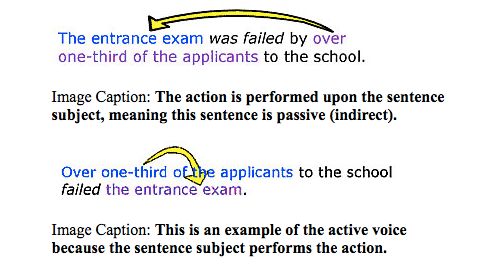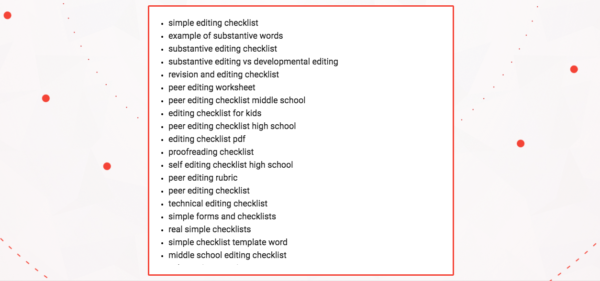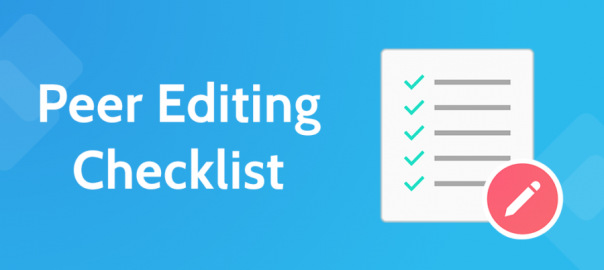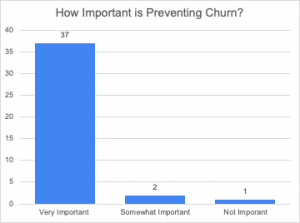
An editor is a writer’s best friend.
For me, that’s literally the case. I’ve known Ben Mulholland since my school days…
But for you, an editor is your best friend because nothing helps a writer grow faster than a great editor.
How will you know if what you’re writing is any good? You write to the best of your abilities, so to you even the most poorly received article was supposed to be good.
An editor, however, will be able to sniff out weakness straight away.
- The opening line is weak
- I lost interest during this paragraph
- You don’t source this quote
And so on…
So you need an editor. And an editor needs a peer editing checklist.
At Process Street, we use checklists for everything we do. We have a pre-publish checklist for blog posts and marketing emails. We have a checklist for keyword research. We even have a checklist for making checklists.
In this post, I want to share with you our peer editing checklist for training writers and editors to become the best they can be, and creating stellar blog content.
Let’s go!
P.S: Scroll right to the bottom for an interactive version of this checklist!
Structure and theme:
What are your first impressions of the post?
From reading it through once out loud, you’ll be able to tell where the flow breaks, where you got bored, and all kinds of vital reactions that readers will be experiencing, too.
In this section, you’ll check:
- Read the entire post through once aloud
- The post is interesting
- The post is unique
- The post is actionable
- The structure flows logically
- Subheadings make sense when read alone
- Post is scannable
Read the entire post through once aloud
Reading a post aloud is the best way to find mistakes and dodgy language. Kate Kiefer Lee says she always reads her blog posts out loud because it helps her:
- Catch errors
- Improve the flow
- Write more like you speak
You’ll catch out any unnatural language while reading aloud, and quickly be able to tell how to rewrite it.
The post is interesting
Is the post boring? What kinds of content do you find boring? A good writer can make an interesting article out of pretty much any topic.
For example, I once set about writing about the importance of business processes.
 … Right?
… Right?
Instead, I turned it into a series of stories: NASA blew up a satellite, the most disastrous train-wreck in history happened, and the nuclear reaction at Chernobyl went into meltdown.
That doesn’t sound quite so bad, right? All of these issues happened because of bad processes, so it was the perfect way of showing you how terrible things can be if you don’t bother to follow standard procedure.
According to Neil Patel, there are 9 elements to an interesting blog post:
- A story
- First person writing
- Foreshadowing (in this post…)
- Transition (we’ve looked at X, now we’re going to look at Y)
- Clarity
- Brevity
- Flow and detail (think article, not outline)
- Short sentences
- Scannable chunks of text
The post is unique
Uniqueness is the easiest thing on the list! All you have to do is tell a story from your own experience, or put a personal twist on the post. See at the start where I talk about my friend being my editor?
Also, I couldn’t find another peer-proofing checklist for bloggers on the internet anywhere, so that’s another.
Make sure the post is:
- Telling a story
- Combining data or advice in a unique way
- Sharing an opinion
The post is actionable
Yes, ‘actionable’ does sound like an empty buzzword…
The thing is, it will make or break your blog posts.
If a user doesn’t know what to do with what they’ve just read, or even if they’ve learned anything they can implement, they’re going to be disappointed. And so are you when you look at your traffic.
There are a few simple ways to make posts more actionable, so don’t worry!
- Use ‘for example’, a lot
- Demonstrate with images and screenshots
- Use videos to show how to do something
- Use imperatives to tell your reader what to do
The structure flows logically
Let’s say you’re reading a blog post to find out more about a topic…
What do you expect?
You expect to find out what it is exactly, why you should care, see some examples, and see how to implement it yourself.
And that’s how blog posts you’re editing work, too.
If you’re giving people the ‘how’ before you give them the ‘why’, they’re less likely to read on.
Here’s the anatomy of a perfect blog post, according to CoSchedule:

Subheadings make sense when read alone
Subheadings need to convey value and make enough sense on their own to show the reader what the post contains. Cut vague subheadings like ‘What happened?’ and ‘Why this matters’ — use scannable headings that add value.
Post is scannable
It’s a fact that readers on the web are going to scan your post whether you think that’s good or not. The best thing you can do is to make it scannable, because readers will first scan the main points to determine whether or not they should bother reading the post.
Show them that it’s worth it by:
- Using images
- Using bullet points or numbered lists
- Using short one-line paragraphs
If a post looks like one massive wall of text, no-one’s going to read it. You’ll get a high bounce rate, it’ll kill your SEO, and it offers a bad user experience.

At Process Street, we make it a rule that no paragraph can be over two sentences in length.
Line editing:
After going through the piece as a whole, you need to check it word by word, line by line.
Most people think that this is the only part of editing you need to do, but that’s totally wrong. Editing is everything from tone, to style, to content. Not just spelling and grammar.
Included in this section:
- Run spelling & grammar check
- Opening line grabs the reader’s attention
- Remove filler words
- Remove passive voice where possible
- Hyphenation is correct
- Call to action at the end
Run spelling & grammar check
If the writer didn’t have Grammarly installed while writing, it’s your job to double-check the post for spelling and grammar problems.
Common issues include:
- Confused homonyms (there, they’re)
- Missing comma after introductory clause
- Missing apostrophes
Make sure the opening line grabs the reader’s attention
The best content and copy keeps readers hooks right from the start. The first sentence drags readers onto the next one. The next one takes them further and further down the page.
It all starts with a great opening line! Brian Dean’s the master at this, and even has his own formula for you to do the same.

You can see this exact technique in action on his post about squeeze pages:

Remove filler words
Actually, probably, really, very, possibly, like, pretty, which is.
Filler words suck the life out of your content, and you’re better off deleting all of them.
This top 10 list from Erin Feldman shows the most common examples:
- Just
- So
- Very
- Really
- That
- And then
- But
- Of
- Some
- Like
Remove the passive voice where possible
It’s best to describe the passive voice with an example:

When you’re speaking indirectly (the window was broken by the boy), it makes it harder for the reader to make sense of what’s being said, and uses unnecessary words.
Action: Instead of saying ‘the window was broken by the boy’, say ‘the boy broke the window’. Much better.
Hyphenation is correct
Hyphenation is complex, but you want to get it right to avoid confusion. It’s not one of those rules that could be thrown away, because without correct usage you could end up making silly mistakes. For example:
- Confusing: Springfield has little town charm.
- With hyphen: Springfield has little-town charm.
There are 20 different rules for using hyphens. If you’re unsure, or think that a word seems wrong when hyphenated, check that guide for a quick reference point.
Call to action at the end
When the reader’s finished your blog post, what’s the next thing you want them to do? Share, comment, buy your product?
Since blog posts are there for marketing purposes, you need to make sure the post is focused on its end goal.

Action: Add a call to action at the end of the blog post. Check here for the different kinds you can use.
On-page SEO:
Aside from getting backlinks, optimizing the content for search is the 2nd most important thing you can do to make sure you’re in for a chance of getting as much organic search traffic as possible.
This means you need to make sure that:
- The keyword is in the title
- The keyword is in the first 100 words
- The meta-description contains the keyword
- The post contains LSI keywords
- H2s are keyword optimized
- Image alt tags are keyword optimized
- Slug contains keyword
- 5+ outbound authority links
- 5+ deep links
- Content is over 1,800 words long
The keyword is in the title
In the words of Brian Dean:
“The title tag is a webpage’s second most important piece of content (besides the content of the page) and therefore sends a strong on-page SEO signal.”
Action: Always make sure to use the keyword in the title of the page, especially closer to the start of the title. For example: ‘SEO Tips: 38 Ways to Boost Organic Traffic’.
The keyword is in the first 100 words
SEO tool SEMRush says:
“It is an essential signal of relevancy to have a keyword appearing in the first 100 words of a page’s content. For less valuable keyword synonyms use second paragraph and so on.”

Action: Make sure to drop your target keyword in the first paragraph.
The meta description is properly optimized
When you include the keyword in your description, it will show up in bold in the search results and reassure the searcher they’re going to click on the right result. Here’s an example of a good meta description:

Use a tool like Yoast or All in One SEO to easily edit the meta descriptions in posts so they’re:
- 160 characters or less
- Including the keyword
- Persuading readers to click
The post contains LSI keywords
Latent Semantic Indexing (LSI) keywords are terms that Google judges to be related in some way. When you use them in your content to support your main keyword, you’re signaling to Google that your post covers a wide range of related topics, and you’re in for a better chance of ranking for more long-tail terms.
There’s a really quick way to find them, too — LSIGraph. It shows you a ton of terms, and you pick the relevant ones to sprinkle throughout the post.

H2s are keyword optimized
Sub-headers (H2s and below) give the post structure and hierarchy, but also indicate the key points of the post to Google. While sub-headers don’t have to be exact match keywords to your target, they should be related and helpful for users as they skim read.

Image alt tags are keyword optimized and helpful
Alt tags are important for a couple of reasons:
- They help images from your post rank in Google Images, increasing search visibility
- If a user’s browser isn’t displaying images, the alt tag will appear and describe the image instead
While it’s not necessary to include the exact keyword in your alt tag (especially if it isn’t an accurate description), make sure to use logical descriptions.

Slug contains keyword
The URL is a known ranking signal for Google, and cutting it down to the keyword strengthens the signal and increases readability for users.

Think about which looks better:
- process.st/peer-editing-checklist
- process.st/category/editing/2016/10/13/29-point-peer-editing-checklist-for-creating-exceptional-content
3+ external authority links
Outbound links show Google your page is backed up with research, and deserves to treated with authority. It shows Google what kind of content your page is associated with and gives you the chance to build relationships with other bloggers because they’ll be happy you’re linking to them.

ShoutMeLoud advises you to:
- Link to pages which actually add value and cover the topic very well.
- Link to articles having good page authority or domain authority.
- Link to articles which have got high number of social media share. (Though do consider other factors like authenticity of the site)
- Link to the bloggers in your network or in your niche, helping you to create a community with fellow bloggers.
Action: A good place to start for adding outbound links is finding sources for every claim you make, and linking to Wikipedia articles for explanations of concepts.
5+ internal links
Never overlook the power of internal links for SEO and user experience. According to Moz, deep links are important because:
- They allow users to navigate a website.
- They help establish information hierarchy for the given website.
- They help spread link juice (ranking power) around websites.
Deep links help Google establish where your content stands in relation to the other pages on your site. What other pages that it’s ranking does this page relate to? It also passes authority to other pages on your site. With solid deep linking, you can often rank for easy search terms without much extra effort.

Content is over 2000 words long
While it is true that people’s attention spans on the internet are woeful, it’s also a fact that longer content ranks better in search engines. If a reader is interested enough in the post, they’ll appreciate detail over brevity any day, especially when it comes to useful, linkable, and sharable resources:

Google does admit that 90% of the time, users are turning to Google for a quick answer to a question, but users do spend 10% of their time looking for long-form content, so Google ranks it.
“Users often turn to Google to answer a quick question, but research suggests that up to 10% of users’ daily information needs involve learning about a broad topic. That’s why today we’re introducing new search results to help users find in-depth articles.” — Pandu Nayak, Google Panda Algorithm Technical Staff
Action: If the content doesn’t reach at least 2,000 words, make notes on how the writer can expand it. Descriptions of ‘what’ and ‘why’ make good opening sections.
Get an interactive version of this peer-editing checklist:
Business & Finance Articles on Business 2 Community
(160)
Report Post






